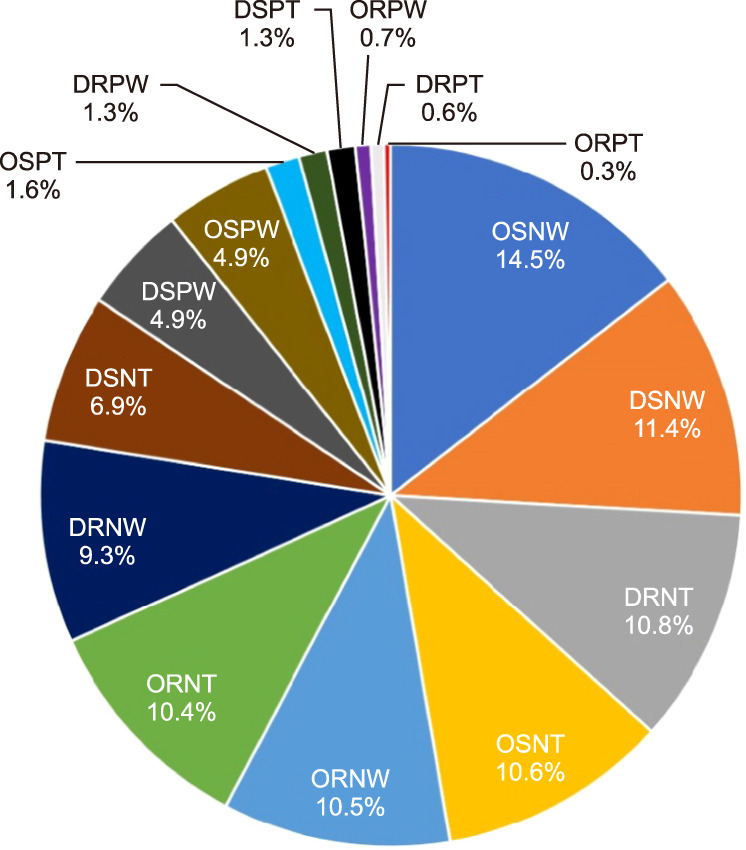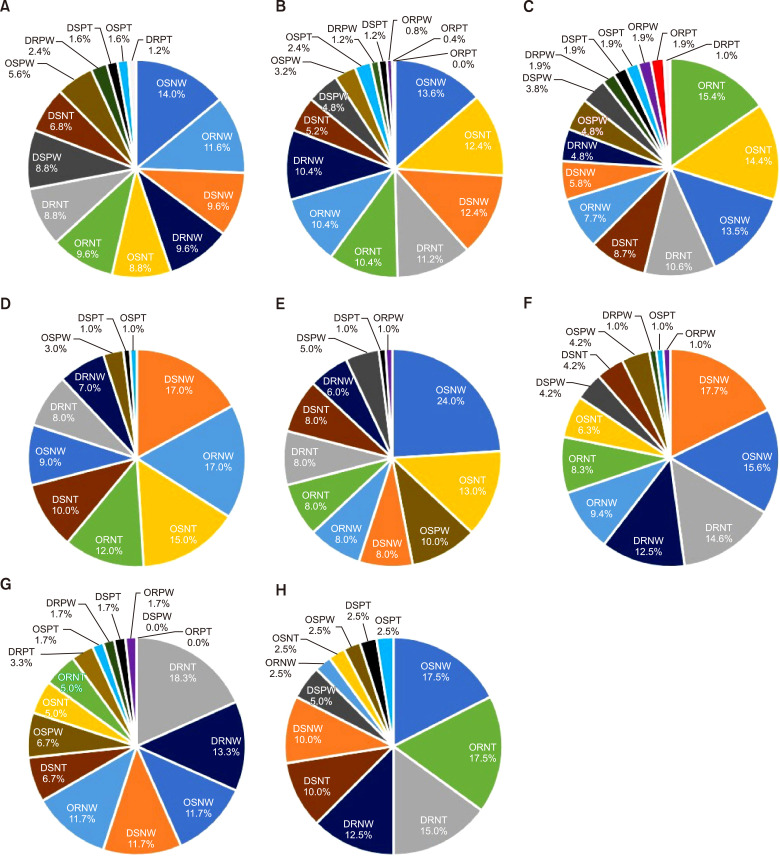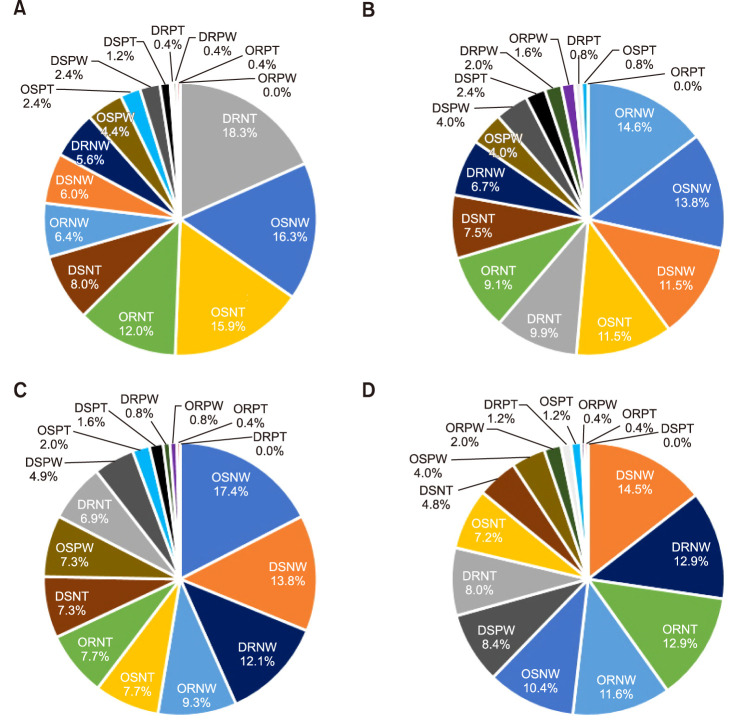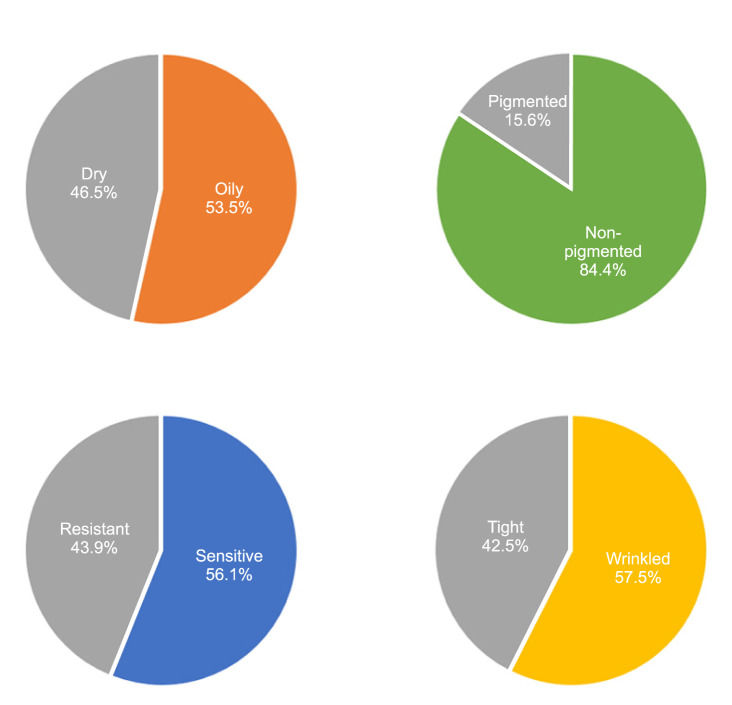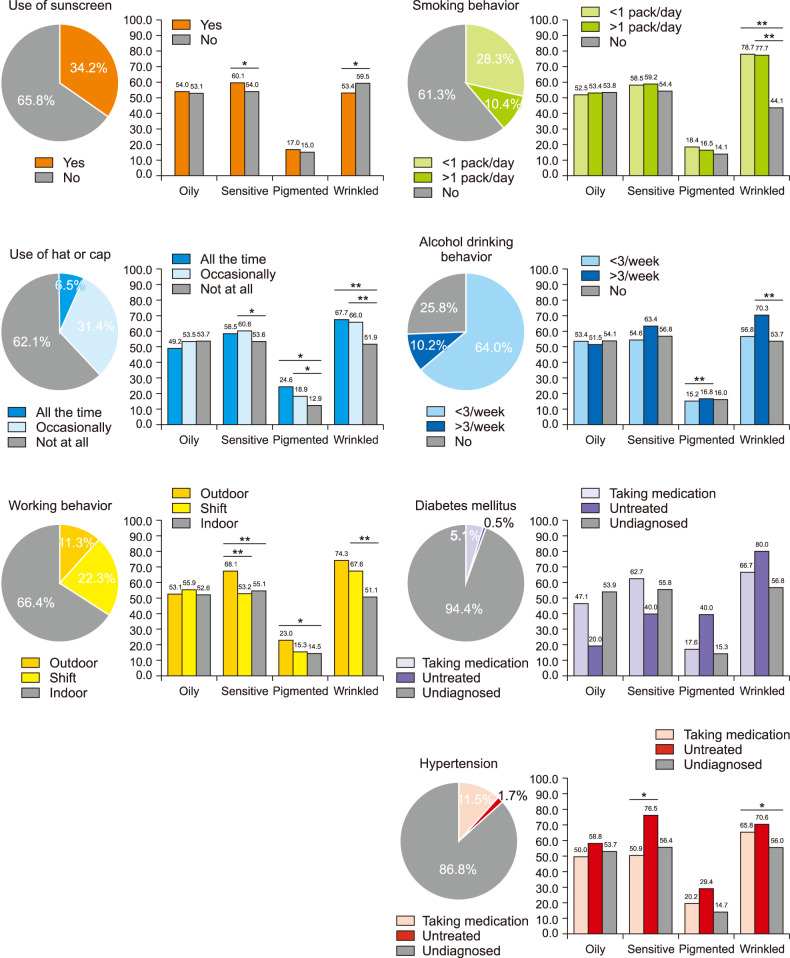Ann Dermatol.
2019 Dec;31(6):621-630. 10.5021/ad.2019.31.6.621.
Baumann Skin Type in the Korean Male Population
- Affiliations
-
- 1Department of Dermatology, Yonsei University Wonju College of Medicine, Wonju, Korea. ahnsk@yonsei.ac.kr
- 2Chungdam Gowoonsesang, Dr. G Dermatology Clinic, Seoul, Korea.
- 3Chungdam Hana Dermatolgic Clinic, Seoul, Korea.
- 4Department of Dermatology, National Police Hospital, Seoul, Korea.
- 5Department of Dermatology, Yonsei University College of Medicine, Seoul, Korea.
- 6Department of Dermatology, Gangnam Severance Hospital, Yonsei University College of Medicine, Seoul, Korea.
- 7Department of Dermatology, Kyungpook National University School of Medicine, Daegu, Korea.
- 8Department of Dermatology, Pusan National University School of Medicine, Busan, Korea.
- 9Department of Dermatology, Chonnam National University Medical School, Gwangju, Korea.
- 10Kims Dermatologic Clinic, Busan, Korea.
- 11Department of Dermatology, Wonkwang University School of Medicine, Iksan, Korea.
- 12Department of Dermatology, Soonchunhyang University College of Medicine, Seoul, Korea.
- 13Yonsei Dermatologic Clinic, Jeju, Korea.
- 14Deparment of Dermatology, Inje University Seoul Paik Hospital, Seoul, Korea.
- 15Severance Dermatologic Clinic, Daegu, Korea.
- 16DS Dermatologic Clinic, Daejeon, Korea.
- 17Jang Dermatologic Clinic, Incheon, Korea.
- KMID: 2461984
- DOI: http://doi.org/10.5021/ad.2019.31.6.621
Abstract
- BACKGROUND
Research into the Baumann skin type (BST) has recently expanded, with growing interest in the development of an efficient and effective skin type classification system for better understanding of this skin condition.
OBJECTIVE
We aimed to identify male-specific skin type characteristics with investigation into the distribution of BST by age and region in the Korean male population and to determine the intrinsic and extrinsic factors related to skin type.
METHODS
A questionnaire was administered to collect information about age, region, working behavior, drinking behavior, smoking behavior, usual habit of sun protection, medical history, and the BST which consisted of four parameters; oily (O) or dry (D), sensitive (S) or resistant (R), pigmented (P) or non-pigmented (N), and wrinkled (W) or tight (T).
RESULTS
We surveyed 1,000 Korean males aged between 20 and 60 years who were divided equally by age and region. Of the total respondents, OSNW type accounted for the largest percentage and ORPW type the lowest. In terms of Baumann parameters, O type was 53.5%, S type was 56.1%, N type was 84.4% and W type was 57.5%. Several behavioral factors were found to have various relationships with the skin type.
CONCLUSION
The predominant skin type in the Korean male respondents was OSNW type, and the distribution of skin types with regards to age and region was reported to be distinct. Therefore, skin care should be customized based on detailed skin types considering the various environmental factors.
MeSH Terms
Figure
Reference
-
1. Fitzpatrick TB. The validity and practicality of sun-reactive skin types I through VI. Arch Dermatol. 1988; 124:869–871. PMID: 3377516.
Article2. Roberts WE. Skin type classification systems old and new. Dermatol Clin. 2009; 27:529–533. viiiPMID: 19850202.
Article3. Baumann L. The skin type solution: a revolutionary guide to your best skin ever. New York: Bantam Books;2006. p. 4–26.4. Baumann L. Understanding and treating various skin types: the Baumann Skin Type Indicator. Dermatol Clin. 2008; 26:359–373. viPMID: 18555952.
Article5. Ahn SK, Jun M, Bak H, Park BD, Hong SP, Lee SH, et al. Baumann skin type in the Korean female population. Ann Dermatol. 2017; 29:586–596. PMID: 28966515.
Article6. Jia Y, Gan Y, He C, Chen Z, Zhou C. The mechanism of skin lipids influencing skin status. J Dermatol Sci. 2018; 89:112–119. PMID: 29174114.
Article7. Tončić RJ, Kezić S, Hadžavdić SL, Marinović B. Skin barrier and dry skin in the mature patient. Clin Dermatol. 2018; 36:109–115. PMID: 29566915.
Article8. Li Z, Hu L, Elias PM, Man MQ. Skin care products can aggravate epidermal function: studies in a murine model suggest a pathogenic role in sensitive skin. Contact Dermatitis. 2018; 78:151–158. PMID: 29152821.
Article9. Berardesca E, Farage M, Maibach H. Sensitive skin: an overview. Int J Cosmet Sci. 2013; 35:2–8. PMID: 22928591.
Article10. Kammeyer A, Luiten RM. Oxidation events and skin aging. Ageing Res Rev. 2015; 21:16–29. PMID: 25653189.
Article11. Augustin M, Kirsten N, Körber A, Wilsmann-Theis D, Itschert G, Staubach-Renz P, et al. Prevalence, predictors and comorbidity of dry skin in the general population. J Eur Acad Dermatol Venereol. 2019; 33:147–150. PMID: 29953684.
Article12. Cowdell F, Dyson J, Long J, Macleod U. Self-reported skin concerns: an epidemiological study of community-dwelling older people. Int J Older People Nurs. 2018; 13:e12195. PMID: 29577628.
Article13. Caretti KL, Mehregan DR, Mehregan DA. A survey of self-reported skin disease in the elderly African-American population. Int J Dermatol. 2015; 54:1034–1038. PMID: 25428122.
Article14. Misery L, Jourdan E, Huet F, Brenaut E, Cadars B, Virassamynaïk S, et al. Sensitive skin in France: a study on prevalence, relationship with age and skin type and impact on quality of life. J Eur Acad Dermatol Venereol. 2018; 32:791–795. PMID: 29397030.
Article15. Baumann L. Validation of a questionnaire to diagnose the Baumann skin type in all ethnicities and in various geographic locations. J Cosmet Dermatol Sci Appl. 2016; 6:34–40.
Article16. Hudjashov G, Villems R, Kivisild T. Global patterns of diversity and selection in human tyrosinase gene. PLoS One. 2013; 8:e74307. PMID: 24040225.
Article17. Yin L, Coelho SG, Ebsen D, Smuda C, Mahns A, Miller SA, et al. Epidermal gene expression and ethnic pigmentation variations among individuals of Asian, European and African ancestry. Exp Dermatol. 2014; 23:731–735. PMID: 25055985.
Article18. Hamer MA, Pardo LM, Jacobs LC, Ikram MA, Laven JS, Kayser M, et al. Lifestyle and physiological factors associated with facial wrinkling in men and women. J Invest Dermatol. 2017; 137:1692–1699. PMID: 28392345.19. Sadick NS. The pathophysiology of the male aging face and body. Dermatol Clin. 2018; 36:1–4. PMID: 29108539.
Article20. Keaney TC. Aging in the male face: intrinsic and extrinsic factors. Dermatol Surg. 2016; 42:797–803. PMID: 27196541.
Article21. Rahrovan S, Fanian F, Mehryan P, Humbert P, Firooz A. Male versus female skin: what dermatologists and cosmeticians should know. Int J Womens Dermatol. 2018; 4:122–130. PMID: 30175213.
Article22. Kim BY, Choi JW, Park KC, Youn SW. Sebum, acne, skin elasticity, and gender difference - which is the major influencing factor for facial pores. Skin Res Technol. 2013; 19:e45–e53. PMID: 22211382.
Article23. Draelos ZD. Cosmeceuticals for male skin. Dermatol Clin. 2018; 36:17–20. PMID: 29108541.
Article24. Andersen LK, Davis MD. Sex differences in the incidence of skin and skin-related diseases in Olmsted County, Minnesota, United States, and a comparison with other rates published worldwide. Int J Dermatol. 2016; 55:939–955. PMID: 27009931.
Article25. Miller IM, Zarchi K, Ellervik C, Jemec GB. Self-reported skin morbidity in Denmark: a population-based cross-sectional study. Eur J Dermatol. 2016; 26:281–286. PMID: 27210463.
Article
- Full Text Links
- Actions
-
Cited
- CITED
-
- Close
- Share
- Similar articles
-
- Identifying Skin Type using the Baumann Skin Type Questionnaire in Korean Women Who Visited a Dermatologic Clinic
- Which Skin Type Is Prevalent in Korean Post-Adolescent Acne Patients?: A Pilot Study Using the Baumann Skin Type Indicator
- Treatment of Displaced Flexion Type Supracondylar Fractures of the Humerus in Children: Comparison with Extension Type
- The Normal Humero-Capitellar Angle in Children ; Baumann Angle and Lateral Humero-Capitellar Angle
- Baumann Skin Type in the Korean Female Population

